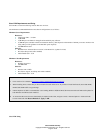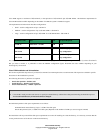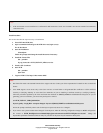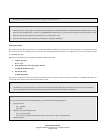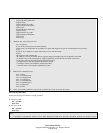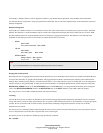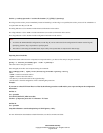
Cisco Internal Use Only
Copyright © 2006 Cisco Systems, Inc. All rights reserved.
Page 57 of 66
Cisco PVM is a database intensive software application. Similar to any database-driven application, Cisco PVM has some maintenance
activities that the user can perform to ensure good performance and trouble free use. The most important aspect of the maintenance activities is
database management.
Database Management
Cisco PVM uses 2 database instances to store the data it collects. Raw traffic statistics that are collected by the system are stored in the OLTP
database. This database is a relational database and also contains the configuration information like devices, DSGs and users for Cisco PVM.
The other database instance is an OLAP database where Cisco PVM stores aggregated information. This database is non-relational and is
optimized for data mining and retrieval. The instance ids and the default roles are as follows:
– OLTP:
SID: CNAM
User: cnam / manc1521 Role: USER
– OLAP:
SID: SPDW
User: tadw / tadw Role: USER
– OLTP & OLAP:
tadwop / tadwop Role: Operator
dw/password Role: DBA
Note:
1. It is recommended that the user change these database passwords after installation.
Purging and retention period
Raw traffic statistics are aggregated and converted into OLAP artifacts by Cisco PVM. Raw traffic statistics are retained in the OLTP datastore
for 2 days after which they are purged from the database. The aggregated data in OLAP is retained based on retention policies defined in the
database. These retention periods default to 3 months for hourly data, 1 year for daily data and 3 years for monthly data. You can change these
retention periods by using standard SQL to modify the records in the database. To change the OLTP retention period, change the value of the
RETENTION_PERIOD column in the TA_RETENTION table of the CNAM database. To change the OLAP retention period, change the
values of the RETENTIONPERIOD column in the RETENTION table of the SPDW database. Login as dw to make the changes.
The purge process in Cisco PVM is enabled by default and cannot be disabled.
Archiving
Cisco PVM allows the user to archive, the data that has been collected and aggregated and the configuration information from Cisco PVM for
storage. The archive process has many options that the user can specify to either schedule the archive or run immediately. Using the appropriate
switches, the user can archive both raw traffic statistics, historical data, and backup configuration information for later use on another
installation of Cisco PVM.
The archive process is disabled by default. When enabled, the archive process archives only that information not previously archived. Archives
can be re-imported into Cisco PVM. This re-imported data is not archived again.
The archive process can be enabled or disabled by using the following command:
$su – pvmadm





